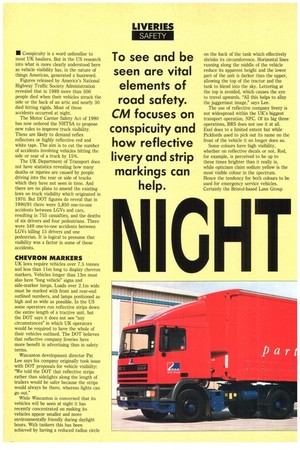• Conspicuity is a word unfamiliar to most UK hauliers.
Page 44

Page 45

If you've noticed an error in this article please click here to report it so we can fix it.
But in the US research into what is more clearly understood here as vehicle visibility has, in the nature of things American, generated a buzzword.
Figures released by America's National Highway Traffic Society Administration revealed that in 1989 more than 500 people died when their vehicles struck the side or the back of an artic and nearly 30 died hitting rigids. Most of these accidents occurred at night.
The Motor Carrier Safety Act of 1990 has now ordered the NHTSA to propose new rules to improve truck visibility. These are likely to demand reflex reflectors or highly reflective red and white tape. The aim is to cut the number of accidents involving vehicles hitting the side or rear of a truck by 15%.
The UK Department of Transport does not have statistics revealing how many deaths or injuries are caused by people driving into the rear or side of trucks which they have not seen in time. And there are no plans to amend the existing laws on truck visibility which originated in 1970. But DOT figures do reveal that in 1990/91 there were 5,850 one-to-one accidents between LGVs and cars, resulting in 755 casualties, and the deaths of six drivers and four pedestrians. There were 549 one-to-one accidents between LGVs killing 15 drivers and one pedestrian. It is logical to presume that visibility was a factor in some of these accidents.
CHEVRON MARKERS
UK laws require vehicles over 7.5 tonnes and less than 11m long to display chevron markers. Vehicles longer than 13m must also have "long vehicle" signs and side-marker lamps. Loads over 2.1m wide must be marked with front and rear-end outlined numbers, and lamps positioned as high and as wide as possible. In the US some operators run reflective strips down the entire length of a tractive unit, but the DOT says it does not see "any circumstances" in which UK operators would be required to have the whole of their vehicles outlined. The DOT believes that reflective company liveries have more benefit in advertising than in safety terms.
Wincanton development director Pat Lee says his company originally took issue with DOT proposals.for vehicle visibility: "We told the DOT that reflective strips rather than sidelights along the length of trailers would be safer because the strips would always be there, whereas lights can go out."
While Wincanton is concerned that its vehicles will be seen at night it has recently concentrated on making its vehicles appear smaller and more environmentally friendly during daylight hours. With tankers this has been achieved by having a reduced radius circle
on the back of the tank which effectively shrinks its circumference. Horizontal lines running along the middle of the vehicle reduce its apparent height and the lower part of the unit is darker than the upper, allowing the top of the tractor and the tank to blend into the sky. Lettering at the top is avoided, which causes the eye to travel upwards. "All this helps to allay the juggernaut image," says Lee.
The use of reflective company livery is not widespread within the UK's biggest transport operation, NFC. Of its big three operations, BRS does not use it at all. Exel does to a limited extent but while Pickfords used to pick out its name on the front of the vehicle it no longer does so.
Some colours have high visibility, whether on reflective decals or not. Red, for example, is perceived to be up to three times brighter than it really is, while opticians claim sodium yellow is the most visible colour in the spectrum. Hence the tendency for both colours to be used for emergency service vehicles. Certainly the Bristol-based Lane Group 'ZITIZ7NinTgTSEINIT117317MI
and blue livery earlier this y we chose our livery we avoi colour for safety reasons," sa director Rebecca Jenkins.
"We have applied reflectiv some of our fleet and are 1 at extending it to more vehi Jenkins. She says the compa everything it can to promote If asked to name one oper reflective livery, it is likely users will have noticed BT, distinctive fluted logo shinin its 80,000 commercial vehicl was part of a £60m package three years to develop.
BT says it did its homewo settling for the new design a the familiar glaring yellow fo greys, blues and reds. Toad paramount importance," says we planned the new logos w experiments using different c vehicles with both reflective non-reflective decals."
Information was exchange public utilities and BT consul and examined accident statis
VEHICLE GRAPHIC
Cost is bound to be a factor deciding whether to take the and go reflective. Vehicle gr. specialist Vinyl Graphics of noticed more operators swit reflective liveries, but direct Ayerst says: "With the past t years of recession the enthu been dampened." The compa provided graphics for Trebor United Biscuits, Mars, Coura operator Data Express, whic for reflective gold.
State of the art in reflecti available from 3M which has video of its "conspicuity pro shows the company's diamon reflective material which is c 10 times more reflective tha if used to outline a vehicle, c from any angle. The product becoming available in the U
Optometry expert Jack Da lecturer at City University, i that reflective strips down the side of a vehicle help roa "Look at the police," he says cars have reflective side stri word 'police' in reflective let they have the maximum pro being seen. When you see a on television you can always the police."
Davey adds that applying principle to trucks must pro road users with a better cha outline the vehicle gives the idea of what he is looking at at seem n a cou sle of come
















































































